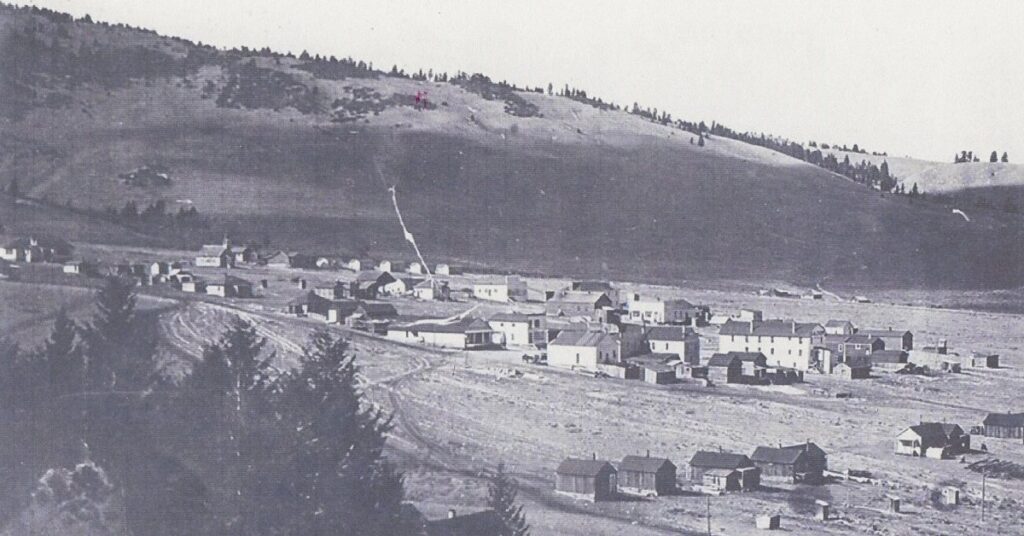
Important Gilmore Information:
Superfund Information – This page has information regarding the EPA/IDEQ activities around Gilmore.
News – News section for Gilmore, Idaho.
A place called Gilmore Idaho – A Facebook group dedicated to the history of Gilmore, Idaho
Gilmore, Idaho, is a ghost town nestled in Lemhi County near Leadore. Founded in the late 1800s as a mining community, Gilmore thrived with the discovery of silver and lead, swelling to a population of around 600 people at its peak. The town was vibrant and bustling, supported by the flourishing local mines. However, the early 1900s brought a sharp decline in silver prices, leading to the closure of many mines and a gradual exodus of its inhabitants. By the 1950s, Gilmore had mostly been abandoned, leaving behind a scattering of silent structures and echoes of its once lively existence.
Today, Gilmore remains an unincorporated townsite characterized by a mix of private land ownership. It boasts a handful of private cabins and RVs dotted across the landscape, with the mountains above cradling the old mining claims now on private property. Visitors can still stroll through the town and discover historical remnants like the old General Store and Pearson’s houses, which stand as testaments to Gilmore’s bustling past.
Surrounded by expansive public land peppered with UTV/ATV trails and crowned by Meadow Lake atop the mountain, Gilmore transforms into a modest resort town during the summer months. This seasonal revival attracts tourists and adventurers alike, drawn to its historical allure and the recreational opportunities afforded by its rugged, scenic backdrop. Today, Gilmore is a cherished destination for those intrigued by the history of mining and the charm of exploring ghost towns.
Interesting Reads:
The Gilmer and Salisbury Stage Company
The Gilmer and Salisbury Stage Company, established in 1866 by Jack Gilmer and Monroe Salisbury, played a pivotal role in the development of transportation across the American West during the late 19th century. This stagecoach company expanded its operations across several states including Idaho, Montana, Utah, and Wyoming. It was crucial in connecting various small towns and mining camps to larger markets and was instrumental in carrying mail, transporting passengers, and hauling freight across the rugged terrains of the West.
[Related: The Gilmer and Salisbury Stage Company]
In their heyday, Gilmer and Salisbury bought out several other lines, including the Utah and Montana branches of Wells, Fargo & Co., and the Cheyenne and Black Hills Stage, Mail, and Express Line in 1876, establishing a vast network that stretched from the Canadian border to southern Utah and from the Great Plains to the Sierra Nevada and Cascade Mountains. They took over existing lines and expanded their services, including taking over the two-year-old California & Arizona Stage Company in 1878 to provide service along new routes in the Southwest.
However, the operations faced challenges such as banditry and attacks, adding risks to their journeys. A significant incident that contributed to the company’s decline involved a horse that transmitted a disease, leading to a lawsuit that financially impacted the company, ultimately leading to its dissolution by the end of the 19th century.
Interestingly, the legacy of Jack Gilmer also lives on in Gilmore, Idaho, a town named after him. Due to a spelling error by the post office, the intended name “Gilmer” was recorded as “Gilmore,” and the error was never corrected, causing the name to stick. This name choice was influenced by the Ross brothers, who founded the town and wanted to honor Gilmer after his stagecoach business was overtaken by the advent of trains, symbolizing their sympathy and respect for his contributions.
The Gilmore and Pittsburgh Railroad
The Gilmore and Pittsburgh Railroad was a standard-gauge railway that operated in Idaho and Montana during the early 1900s. The railroad was built to transport ore from the mines in the Gilmore and Pittsburgh mining districts to the nearest railhead, which was located in Armstead, Montana.
[Related: The Gilmore and Pittsburgh Railroad]
The railroad was constructed between 1910 and 1912, and at its peak, it extended for 64 miles from Salmon, Idaho, to Armstead, Montana. The line passed through rugged and mountainous terrain, with steep grades and sharp curves. It was operated by steam locomotives and used small ore cars to transport the ore.
The Gilmore and Pittsburgh Railroad played an important role in the development of the mining industry in the area, allowing for the efficient transportation of ore from the mines to the nearest railhead. However, the railroad faced many challenges, including difficult terrain, harsh weather conditions, and financial difficulties. It ceased operations in the mid-1930s, and today, only a few remnants of the railroad and its equipment remain.
